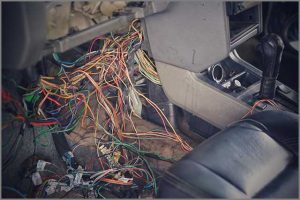Understanding and Repairing Automotive Wiring Harnesses
The automotive wiring harness is a critical component in modern vehicles, ensuring the smooth operation of various electrical systems. This article will delve into the intricacies of automotive wiring harnesses, how they function, common issues, and steps for repair. Understanding and Repairing Automotive Wiring Harnesses
What is an Automotive Wiring Harness?
Definition and Function
An automotive wiring harness is a collection of wires, connectors, and terminals that transmit electrical power and signals to various parts of a vehicle. It plays a crucial role in connecting components like the engine, lights, sensors, and electronic control units (ECUs), ensuring they work in harmony.

Components of a Wiring Harness
A typical wiring harness includes:
Wires: Conductors that carry electrical current.
Connectors: Join wires to components or other wires.
Terminals: End points of wires that connect to devices.
Protective coverings: Shields wires from physical damage and environmental factors.
Common Problems with Automotive Wiring Harnesses
Symptoms of a Faulty Wiring Harness
Identifying wiring harness issues early can prevent more serious problems. Common symptoms include:
Intermittent electrical failures: Flickering lights or inconsistent power to components.
Non-functioning systems: Features like power windows or headlights suddenly stop working.
Burnt smell or visible damage: Overheating wires can produce a burnt odor, and physical damage can be visible.
Causes of Wiring Harness Failures
Several factors can contribute to wiring harness failures:
Physical damage: Abrasion, cuts, or impact damage from accidents.
Corrosion: Exposure to moisture can cause terminals and connectors to corrode.
Poor connections: Loose or improperly secured connections can lead to intermittent failures.
Electrical overloads: Excessive current can overheat wires, leading to insulation breakdown and short circuits.
Steps to Repair an Automotive Wiring Harness
1. Diagnosis and Inspection
Before starting any repair, a thorough diagnosis is essential:
Visual inspection: Check for visible signs of damage, such as frayed wires or corroded connectors.
Use a multimeter: Test for continuity, voltage drops, and shorts in the wiring.
Consult wiring diagrams: Refer to the vehicle’s wiring diagrams to understand the circuit layout and identify potential problem areas.
2. Gathering Tools and Materials
Ensure you have the necessary tools and materials for the repair:
Basic tools: Wire cutters, strippers, crimping tools, and screwdrivers.
Soldering equipment: Soldering iron and solder for secure electrical connections.
Replacement parts: Correct gauge wires, connectors, terminals, and protective tubing.
3. Performing the Repair
Follow these steps for an effective repair:
Disconnect the battery: Ensure safety by disconnecting the vehicle’s battery before starting.
Cut and strip damaged wires: Remove the damaged section of the wire, ensuring a clean cut.
Splice in new wire: Use crimp connectors or solder to join the new wire section securely.
Seal and protect: Apply heat shrink tubing or electrical tape to protect the spliced area from moisture and damage.
Reconnect and test: Reconnect the repaired harness, reconnect the battery, and test the system to ensure proper functionality.
Preventive Maintenance for Wiring Harnesses
Regular Inspections
Routine inspections can help catch potential issues before they become major problems:
Check for wear and tear: Regularly inspect the wiring harness for signs of wear, damage, or corrosion.
Ensure secure connections: Verify that all connectors and terminals are tight and free of corrosion.
Protective Measures
Implementing protective measures can extend the lifespan of your wiring harness:
Use protective coverings: Ensure wires are covered with appropriate protective tubing or tape.
Avoid overloading circuits: Do not add aftermarket accessories without ensuring the circuit can handle the additional load.
Conclusion
Understanding and repairing automotive wiring harnesses is essential for maintaining the reliability and functionality of a vehicle’s electrical systems. By knowing the components, common issues, and repair techniques, you can diagnose and address wiring problems effectively. Regular maintenance and preventive measures can further ensure the longevity of your vehicle’s wiring harness, keeping your car running smoothly. https://gatesheadautoelectrics.com.au/auto-electricians-trailers-lights-newcastle/



